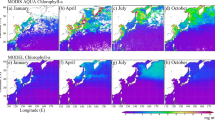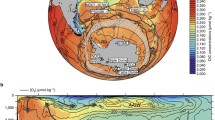Abstract
DIRECT calculation of the air-sea flux of CO2 requires detailed knowledge of the partial pressure of carbon dioxide () and gas-transfer velocities at the surface of the global ocean1, with the available observations of surface suggesting that it varies in a smooth manner with season and position over the major ocean regions2-5. In spring 1989 we mapped surface , total inorganic carbon (TIC), chlorophyll, temperature and salinity at several locations between 47° N and 60° N in the northeast Atlantic near 20° W, observing large variations in on spatial scales of ≪100 km, Correlated with plankton chlorophyll, surface temperature and TIC. The variation of with latitude was in the opposite sense to that previously reported for this region3-5. Thus, in this ocean area and season at least, the air-sea flux is strongly modulated by biological activity and variable on short spatial scales. The inhomogeneity observed suggests that estimates of the oceanic sink for fossil fuel inferred from existing data (relatively sparse even in the North Atlantic) will be subject to significant error.
Similar content being viewed by others
References
Thomas, F., Perigaud, C., Merlivat, L. & Minster, J.-F. Phil. Trans. R. Soc. A325, 71–83 (1988).
Keeling, C. D. J. geophys. Res. 73, 4543–4553 (1968).
Broecker, W. S. et al. J. geophys. Res. 91, 10517–10527 (1986).
Takahashi, T. Oceanus 32, 22–29 (1989).
Tans, P. P., Fung, I. Y. & Takahashi, T. Science 247, 1431–1438 (1990).
Takahashi, T., Chipman, D. Schechtman, N., Goddard, J. & Wanninkhof, R. Lamont-Doherty tech. Rep. Measurements of the partial pressure of CO 2 in discrete water samples during the North Atlantic Transient tracers in the Oceans project (Columbia University, New York, 1982).
Weiss, R. F. J. chromatogr. Sci. 19, 611–616 (1981).
Johnson, K. M., Sieburth, J. McN., Williams, P. J. Ie B & Brandstrom, L. Mar. Chem. 21, 117–133 (1987).
Codispoti, L. A., Friederich, G. E., Iverson, R. L. & Hood, D. W. Nature 296, 242–245 (1982).
Takahashi, T. et al. J. Mar. Res. Inst. Iceland 9, 20–36 (1985).
Peng, T.-H., Takahashi, T., Broecker, W. S. & Olafsson, J. Tellus 39B, 439–458 (1987).
Sverdrup, H. J. Cons. perm. Int. Explor. Mer. 18, 287–295 (1953).
Brewer, P. G., Goyet, C. & Dyrssen, D. Science 246, 477–479 (1989).
Taylor, A. H., Watson, A. J., Ainsworth, M., Robertson, J. E. & Turner, D. R., Global biogechem. Cycles (in the press).
Etcheto, J. & Merlivat, L. J. geophys. Res. 93, 15,669–15,678 (1988).
Williams, R. Hydrobiologia 167/168, 151–159 (1988).
Author information
Authors and Affiliations
Rights and permissions
About this article
Cite this article
Watson, A., Robinson, C., Robinson, J. et al. Spatial variability in the sink for atmospheric carbon dioxide in the North Atlantic. Nature 350, 50–53 (1991). https://doi.org/10.1038/350050a0
Received:
Accepted:
Issue Date:
DOI: https://doi.org/10.1038/350050a0
- Springer Nature Limited
This article is cited by
-
Effect of Sea Surface Temperature Variation on Productivity and Fisheries off Karnataka, West Coast of India
Journal of the Indian Society of Remote Sensing (2021)
-
Seasonal controls on surface pCO2 in the central and eastern Arabian Sea
Journal of Earth System Science (2000)
-
Low interannual variability in recent oceanic uptake of atmospheric carbon dioxide
Nature (1998)
-
Contribution of hurricanes to local and global estimates of air–sea exchange of CO2
Nature (1998)
-
Spatial variability in the primary productivity in the East China Sea and its adjacent waters
Journal of Oceanography (1997)





